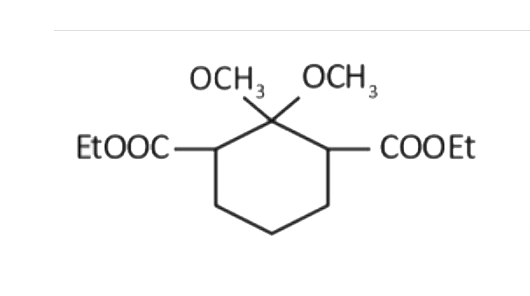PhCH3(i)CrO2Cl2/CCl4−−−−−−−−−−−→(ii)H3O+PhCHO
The above reaction is an example of which name reaction?
Rossenmund reduction
Birch reduction
Mendius reduction
Etard reaction
The correct Answer is:D
To solve the question regarding the reaction of toluene (PhCH₃) to benzaldehyde (PhCHO) in the presence of chromyl chloride (CrO₂Cl₂), carbon tetrachloride (CCl₄), and mineral acid (H₃O⁺), we need to identify the name of the reaction involved.
1. Identify the Reactants and Products:
- The starting compound is toluene (PhCH₃), which contains a methyl group attached to a benzene ring.
- The product of the reaction is benzaldehyde (PhCHO), which contains an aldehyde functional group.
2. Understand the Reaction Conditions:
- The reaction is carried out using chromyl chloride (CrO₂Cl₂) and carbon tetrachloride (CCl₄) as solvents, along with a mineral acid (H₃O⁺).
- Chromyl chloride is a strong oxidizing agent, which suggests that the methyl group in toluene is being oxidized.
3. Recognize the Type of Reaction:
- The reaction involves the oxidation of a methyl group (–CH₃) attached to an aromatic ring (benzene) to form an aldehyde group (–CHO).
- This specific transformation is characteristic of a well-known reaction in organic chemistry.
4. Identify the Name of the Reaction:
- The reaction described is known as the Etard Reaction. In the Etard reaction, a methyl group on an aromatic compound is oxidized to an aldehyde using chromyl chloride.
5. Conclusion:
- Therefore, the reaction of toluene to benzaldehyde in the presence of chromyl chloride and mineral acid is an example of the Etard Reaction.
Final Answer:
The reaction is an example of the Etard Reaction.
---
- The starting compound is toluene (PhCH₃), which contains a methyl group attached to a benzene ring.
- The product of the reaction is benzaldehyde (PhCHO), which contains an aldehyde functional group.
- The reaction is carried out using chromyl chloride (CrO₂Cl₂) and carbon tetrachloride (CCl₄) as solvents, along with a mineral acid (H₃O⁺).
- Chromyl chloride is a strong oxidizing agent, which suggests that the methyl group in toluene is being oxidized.
- The reaction involves the oxidation of a methyl group (–CH₃) attached to an aromatic ring (benzene) to form an aldehyde group (–CHO).
- This specific transformation is characteristic of a well-known reaction in organic chemistry.
- The reaction described is known as the Etard Reaction. In the Etard reaction, a methyl group on an aromatic compound is oxidized to an aldehyde using chromyl chloride.
- Therefore, the reaction of toluene to benzaldehyde in the presence of chromyl chloride and mineral acid is an example of the Etard Reaction.
The reaction is an example of the Etard Reaction.
Similar Questions
Knowledge Check
Ph−CH3CrO2Cl2−−−−→(A)conc.KOH−−−−−−→Ph−CH2OH+(B)
Product (B) of above the reaction is :APh−CO2HBPh−CO−2CPh−CHODPh−CH3CH3−O∣∣C−O−HNaH14CO3−−−−−→(A)(gas)(i)PhMgBr−−−−−−−→(ii)H3O⊕(B)
CH3−O∣∣S∣∣O−O−HNaH14CO3−−−−−→(C)gas(i)PhMgBr−−−−−−−→(ii)H3O⊕(D)
Product (B) and (D) in the above reaction are :APh−O∣∣C−O−H,Ph−O∣∣S∣∣O−O−HBPh−O∣∣C14−O−H,Ph−O∣∣S−O−HCPh−O∣∣C14−O−H,Ph−O∣∣C14−O−HDPh−O∣∣C−OH,Ph−O∣∣S−O−H
PhCH2CH2CH3(i)CrO2Cl2/CCl4−−−−−−−−−−−−−−→(ii)h2O(A)
The product (A) is:
View SolutionC3H5N(α)Hydrolysis−−−−−→CH3H6O2(x)(i)Cl2/Pred−−−−−−−→(ii)H3O+C3H5O2Cl(y)NH3−−→C3H7O2(z)
correct option (s) is/are for the above reaction.
View Solution2CH3−C∣∣O−CH3Mg/Hg−−−−→H+ Product in the reaction is
View SolutionConsider the following reaction.
CH3O16∣∣C−O18−C2H5+H2O16H+−−→Heat
The products formed in the reaction are
View SolutionCl2NaOH−−−→NaCl+NaClO3+H2O
The equivalent mass of Cl2 in the above reaction is
View Solution(CH3)2CONaCN−−−→HCI(A)H+3O−−→Δ(B)
In the above sequence of reactions, (A) and (B) are :
View Solution

